Opinion & Analysis
The real numbers behind driving the ball on Tour
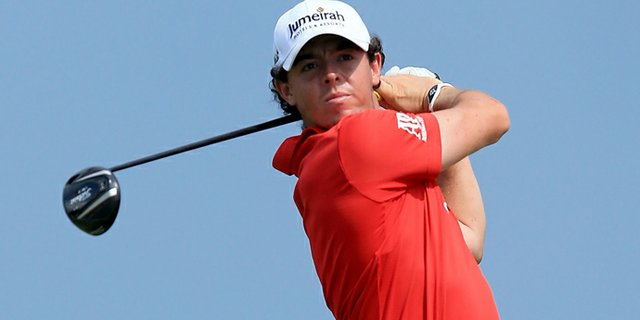
By Rich Hunt
GolfWRX Contributor
In the era of modern technology, advanced fitness regimens and long driving competitions, there has been a growing sentiment towards golf favoring the ‘bomb-n-gouge’ style of play. However, we still see many shorter-hitting golfers like Zach Johnson who are successful in the game. Most of the clients on Tour I work with have questioned the advantages that power can have on Tour versus hitting the ball the more accurately. As a competitive amateur golfer myself, it was one of the first things I investigated from a statistical standpoint.
Part of the issue deals with the main metric designed to determine driving skill on Tour, called ‘Total Driving.” Total Driving utilizes a very simple formula by adding the rankings of a player’s Driving Distance and Fairway Percentage together. The lower the combined ranking, the better the golfer will rank in Total Driving. But it’s metrics like Total Driving that have only produced more questions than answers for golfers.
The main issue with the Total Driving metric is that it is flawed from a statistical standpoint and it is a very incomplete formula. From a pure statistical standpoint, the addition of taking the rankings and adding them together is a bad idea in general. Theoretically, a golfer on Tour could hit nothing but 4-irons off the tee and would likely lead the Tour in percentage of Fairways Hit. But, they would also likely be dead last in driving distance. And using the Total Driving formula of adding up the rankings would misrepresent how well the golfer hits the ball off the tee.
In that example, the golf would rank No. 1 in Fairway Percentage and No. 191 in Driving Distance. That would combine for 192 Total Driving points, leaving this particular golfer ranked 100th out of 192 golfers on Tour in Total Driving. However, the reality is that if a Tour golfer hit nothing but 4 irons off the tee, they would almost be guaranteed to be the least effective driver of the ball on Tour, if not in the history of the Tour.
And therein lies part of another issue with Total Driving — it assumes that driving distance is just as important as fairway percentage. When examining Driving Distance and Fairway Percentage to par-4 and par-5 scoring averages, the data shows that they are not of equal importance.
Not wanting to stop at just driving distance and fairway percentage, I examined other metrics as well. The one metric that showed some statistical influence to par-4 and par-5 scoring averages is called “Average Distance to the Edge of the Fairway.” This metric is measured on shots by a Tour player when they miss the fairway.
It’s easy to understand why combining Driving Distance, Fairway Percentage and Distance To the Edge of the Fairway can show a strong correlation to par-4 and par-5 scoring average. Distance helps measure power, fairway percentage helps measure accuracy and distance to the edge of the fairway helps measure precision. Now the question becomes putting it in a formula to best represent its effect on Tour players and then examine the results.
Eventually I came up with my own metric that I call “Driving Effectiveness.” It combines the metrics of Driving Distance, Fairway Percentage and Average Distance To the Edge of the Fairway. However, it utilizes the actual measurements instead of using the rankings. Furthermore, it weighs those metrics differently to better represent its typical impact on Tour golfers on par-4s and par-5s. Without giving the formula away, I will say that in the end that Driving Distance and Distance to the Edge of the Fairway have a larger impact on a golfer’s score than fairway percentage. But, do not let that fool you into believing that hitting fairways is unimportant.
Here is a table showing the top-10 and bottom-10 players in Driving Effectiveness and the Total Driving metric.
Top-10 in Driving Effectiveness
Bottom 10 in Driving Effectiveness
While there are some similarities between the rankings of the two metrics, there are plenty of players who are not accurately depicted in Total Driving. Here’s a look at the top-10 players who had the largest improvement in Driving Effectiveness ranking from the Total Driving metric.
Here are the players with the largest decline in Driving Effectiveness ranking from the Total Driving metric.
In golfers who had a much better Driving Effectiveness ranking, we see that favoring shorter hitters a little. Conversely, with the golfers with a worse Driving Effectiveness ranking, that has a small bias towards longer hitters. The reason being has to do with the Average Distance To The Edge of the Fairway metric.
However, the bias is somewhat small. I believe the reason for that is regardless of their length off the tee, Tour players do not typically see a sizeable difference in where they rank on Tour between fairway percentage and Average Distance to the Edge of the Fairway.
For example, KJ Choi saw the largest difference in Driving Effectiveness (67th) versus Total Driving (128th). Choi was ranked 54th in fairway percentage, hitting 64.08 percent of his fairways. But, Choi was also 2nd in Average Distance to the Edge of the Fairway, hitting it 18.7 feet from the edge on average. Thus, Choi was more effective than Total Driving indicates because when he did miss the fairway, he did not miss by much.
I think that amateurs can apply the general principles of Driving Effectiveness in their own game as well. If they are looking to become more effective off the tee, the ways to make the largest improvements would be to increase their driving distance (power) and their Distance to the Edge of the Fairway (precision). If they are looking at swing changes or a new driver in order to increase distance, they should focus more on how that may possibly affect their Average Distance To The Edge of the Fairway.
However, if they gain power but lose too much precision they may end up being less effective in the long run. And if they do not believe they can gain any power, they should probably focus their efforts on Fairway percentage (accuracy) and Distance To The Edge of the Fairway (precision) in order become more effective off the tee.
Click here for more discussion in the “Tour Talk” forum.
- LIKE1
- LEGIT0
- WOW0
- LOL0
- IDHT0
- FLOP0
- OB0
- SHANK1
19th Hole
Vincenzi’s 2024 Zurich Classic of New Orleans betting preview

The PGA TOUR heads to New Orleans to play the 2023 Zurich Classic of New Orleans. In a welcome change from the usual stroke play, the Zurich Classic is a team event. On Thursday and Saturday, the teams play best ball, and on Friday and Sunday the teams play alternate shot.
TPC Louisiana is a par 72 that measures 7,425 yards. The course features some short par 4s and plenty of water and bunkers, which makes for a lot of exciting risk/reward scenarios for competitors. Pete Dye designed the course in 2004 specifically for the Zurich Classic, although the event didn’t make its debut until 2007 because of Hurricane Katrina.
Coming off of the Masters and a signature event in consecutive weeks, the field this week is a step down, and understandably so. Many of the world’s top players will be using this time to rest after a busy stretch.
However, there are some interesting teams this season with some stars making surprise appearances in the team event. Some notable teams include Patrick Cantlay and Xander Schauffele, Rory McIlroy and Shane Lowry, Collin Morikawa and Kurt Kitayama, Will Zalatoris and Sahith Theegala as well as a few Canadian teams, Nick Taylor and Adam Hadwin and Taylor Pendrith and Corey Conners.
Past Winners at TPC Louisiana
- 2023: Riley/Hardy (-30)
- 2022: Cantlay/Schauffele (-29)
- 2021: Leishman/Smith (-20)
- 2019: Palmer/Rahm (-26)
- 2018: Horschel/Piercy (-22)
- 2017: Blixt/Smith (-27)
2024 Zurich Classic of New Orleans Picks
Tom Hoge/Maverick McNealy +2500 (DraftKings)
Tom Hoge is coming off of a solid T18 finish at the RBC Heritage and finished T13 at last year’s Zurich Classic alongside Harris English.
This season, Hoge is having one of his best years on Tour in terms of Strokes Gained: Approach. In his last 24 rounds, the only player to top him on the category is Scottie Scheffler. Hoge has been solid on Pete Dye designs, ranking 28th in the field over his past 36 rounds.
McNealy is also having a solid season. He’s finished T6 at the Waste Management Phoenix Open and T9 at the PLAYERS Championship. He recently started working with world renowned swing coach, Butch Harmon, and its seemingly paid dividends in 2024.
Keith Mitchell/Joel Dahmen +4000 (DraftKings)
Keith Mitchell is having a fantastic season, finishing in the top-20 of five of his past seven starts on Tour. Most recently, Mitchell finished T14 at the Valero Texas Open and gained a whopping 6.0 strokes off the tee. He finished 6th at last year’s Zurich Classic.
Joel Dahmen is having a resurgent year and has been dialed in with his irons. He also has a T11 finish at the PLAYERS Championship at TPC Sawgrass which is another Pete Dye track. With Mitchell’s length and Dahmen’s ability to put it close with his short irons, the Mitchell/Dahmen combination will be dangerous this week.
Taylor Moore/Matt NeSmith +6500 (DraftKings)
Taylor Moore has quickly developed into one of the more consistent players on Tour. He’s finished in the top-20 in three of his past four starts, including a very impressive showing at The Masters, finishing T20. He’s also finished T4 at this event in consecutive seasons alongside Matt NeSmith.
NeSmith isn’t having a great 2024, but has seemed to elevate his game in this format. He finished T26 at Pete Dye’s TPC Sawgrass, which gives the 30-year-old something to build off of. NeSmith is also a great putter on Bermudagrass, which could help elevate Moore’s ball striking prowess.
- LIKE6
- LEGIT1
- WOW1
- LOL0
- IDHT0
- FLOP2
- OB1
- SHANK1
19th Hole
Vincenzi’s 2024 LIV Adelaide betting preview: Cam Smith ready for big week down under

After having four of the top twelve players on the leaderboard at The Masters, LIV Golf is set for their fifth event of the season: LIV Adelaide.
For both LIV fans and golf fans in Australia, LIV Adelaide is one of the most anticipated events of the year. With 35,000 people expected to attend each day of the tournament, the Grange Golf Club will be crawling with fans who are passionate about the sport of golf. The 12th hole, better known as “the watering hole”, is sure to have the rowdiest of the fans cheering after a long day of drinking some Leishman Lager.
The Grange Golf Club is a par-72 that measures 6,946 yards. The course features minimal resistance, as golfers went extremely low last season. In 2023, Talor Gooch shot consecutive rounds of 62 on Thursday and Friday, giving himself a gigantic cushion heading into championship Sunday. Things got tight for a while, but in the end, the Oklahoma State product was able to hold off The Crushers’ Anirban Lahiri for a three-shot victory.
The Four Aces won the team competition with the Range Goats finishing second.
*All Images Courtesy of LIV Golf*
Past Winners at LIV Adelaide
- 2023: Talor Gooch (-19)
Stat Leaders Through LIV Miami
Green in Regulation
- Richard Bland
- Jon Rahm
- Paul Casey
Fairways Hit
- Abraham Ancer
- Graeme McDowell
- Henrik Stenson
Driving Distance
- Bryson DeChambeau
- Joaquin Niemann
- Dean Burmester
Putting
- Cameron Smith
- Louis Oosthuizen
- Matt Jones
2024 LIV Adelaide Picks
Cameron Smith +1400 (DraftKings)
When I pulled up the odds for LIV Adelaide, I was more than a little surprised to see multiple golfers listed ahead of Cameron Smith on the betting board. A few starts ago, Cam finished runner-up at LIV Hong Kong, which is a golf course that absolutely suits his eye. Augusta National in another course that Smith could roll out of bed and finish in the top-ten at, and he did so two weeks ago at The Masters, finishing T6.
At Augusta, he gained strokes on the field on approach, off the tee (slightly), and of course, around the green and putting. Smith able to get in the mix at a major championship despite coming into the week feeling under the weather tells me that his game is once again rounding into form.
The Grange Golf Club is another course that undoubtedly suits the Australian. Smith is obviously incredibly comfortable playing in front of the Aussie faithful and has won three Australian PGA Championship’s. The course is very short and will allow Smith to play conservative off the tee, mitigating his most glaring weakness. With birdies available all over the golf course, there’s a chance the event turns into a putting contest, and there’s no one on the planet I’d rather have in one of those than Cam Smith.

Louis Oosthuizen +2200 (DraftKings)
Louis Oosthuizen has simply been one of the best players on LIV in the 2024 seas0n. The South African has finished in the top-10 on the LIV leaderboard in three of his five starts, with his best coming in Jeddah, where he finished T2. Perhaps more impressively, Oosthuizen finished T7 at LIV Miami, which took place at Doral’s “Blue Monster”, an absolutely massive golf course. Given that Louis is on the shorter side in terms of distance off the tee, his ability to play well in Miami shows how dialed he is with the irons this season.
In addition to the LIV finishes, Oosthuizen won back-to-back starts on the DP World Tour in December at the Alfred Dunhill Championship and the Mauritus Open. He also finished runner-up at the end of February in the International Series Oman. The 41-year-old has been one of the most consistent performers of 2024, regardless of tour.
For the season, Louis ranks 4th on LIV in birdies made, T9 in fairways hit and first in putting. He ranks 32nd in driving distance, but that won’t be an issue at this short course. Last season, he finished T11 at the event, but was in decent position going into the final round but fell back after shooting 70 while the rest of the field went low. This season, Oosthuizen comes into the event in peak form, and the course should be a perfect fit for his smooth swing and hot putter this week.

- LIKE10
- LEGIT2
- WOW0
- LOL0
- IDHT0
- FLOP0
- OB0
- SHANK0
Opinion & Analysis
The Wedge Guy: What really makes a wedge work? Part 1

Of all the clubs in our bags, wedges are almost always the simplest in construction and, therefore, the easiest to analyze what might make one work differently from another if you know what to look for.
Wedges are a lot less mysterious than drivers, of course, as the major brands are working with a lot of “pixie dust” inside these modern marvels. That’s carrying over more to irons now, with so many new models featuring internal multi-material technologies, and almost all of them having a “badge” or insert in the back to allow more complex graphics while hiding the actual distribution of mass.
But when it comes to wedges, most on the market today are still single pieces of molded steel, either cast or forged into that shape. So, if you look closely at where the mass is distributed, it’s pretty clear how that wedge is going to perform.
To start, because of their wider soles, the majority of the mass of almost any wedge is along the bottom third of the clubhead. So, the best wedge shots are always those hit between the 2nd and 5th grooves so that more mass is directly behind that impact. Elite tour professionals practice incessantly to learn to do that consistently, wearing out a spot about the size of a penny right there. If impact moves higher than that, the face is dramatically thinner, so smash factor is compromised significantly, which reduces the overall distance the ball will fly.
Every one of us, tour players included, knows that maddening shot that we feel a bit high on the face and it doesn’t go anywhere, it’s not your fault.
If your wedges show a wear pattern the size of a silver dollar, and centered above the 3rd or 4th groove, you are not getting anywhere near the same performance from shot to shot. Robot testing proves impact even two to three grooves higher in the face can cause distance loss of up to 35 to 55 feet with modern ‘tour design’ wedges.
In addition, as impact moves above the center of mass, the golf club principle of gear effect causes the ball to fly higher with less spin. Think of modern drivers for a minute. The “holy grail” of driving is high launch and low spin, and the driver engineers are pulling out all stops to get the mass as low in the clubhead as possible to optimize this combination.
Where is all the mass in your wedges? Low. So, disregarding the higher lofts, wedges “want” to launch the ball high with low spin – exactly the opposite of what good wedge play requires penetrating ball flight with high spin.
While almost all major brand wedges have begun putting a tiny bit more thickness in the top portion of the clubhead, conventional and modern ‘tour design’ wedges perform pretty much like they always have. Elite players learn to hit those crisp, spinny penetrating wedge shots by spending lots of practice time learning to consistently make contact low in the face.
So, what about grooves and face texture?
Grooves on any club can only do so much, and no one has any material advantage here. The USGA tightly defines what we manufacturers can do with grooves and face texture, and modern manufacturing techniques allow all of us to push those limits ever closer. And we all do. End of story.
Then there’s the topic of bounce and grinds, the most complex and confusing part of the wedge formula. Many top brands offer a complex array of sole configurations, all of them admittedly specialized to a particular kind of lie or turf conditions, and/or a particular divot pattern.
But if you don’t play the same turf all the time, and make the same size divot on every swing, how would you ever figure this out?
The only way is to take any wedge you are considering and play it a few rounds, hitting all the shots you face and observing the results. There’s simply no other way.
So, hopefully this will inspire a lively conversation in our comments section, and I’ll chime in to answer any questions you might have.
And next week, I’ll dive into the rest of the wedge formula. Yes, shafts, grips and specifications are essential, too.
- LIKE31
- LEGIT7
- WOW1
- LOL1
- IDHT2
- FLOP3
- OB1
- SHANK3
-

 19th Hole2 weeks ago
19th Hole2 weeks agoDave Portnoy places monstrous outright bet for the 2024 Masters
-

 19th Hole2 weeks ago
19th Hole2 weeks agoTiger Woods arrives at 2024 Masters equipped with a putter that may surprise you
-

 19th Hole16 hours ago
19th Hole16 hours ago‘Absolutely crazy’ – Major champ lays into Patrick Cantlay over his decision on final hole of RBC Heritage
-

 19th Hole3 weeks ago
19th Hole3 weeks agoReport: Tiger Woods has ‘eliminated sex’ in preparation for the 2024 Masters
-

 19th Hole1 week ago
19th Hole1 week agoTwo star names reportedly blanked Jon Rahm all week at the Masters
-

 19th Hole7 days ago
19th Hole7 days agoReport: LIV Golf identifies latest star name they hope to sign to breakaway tour
-

 19th Hole1 week ago
19th Hole1 week agoNeal Shipley presser ends in awkward fashion after reporter claims Tiger handed him note on 8th fairway
-

 19th Hole6 days ago
19th Hole6 days agoBrandel Chamblee has ‘no doubt’ who started the McIlroy/LIV rumor and why

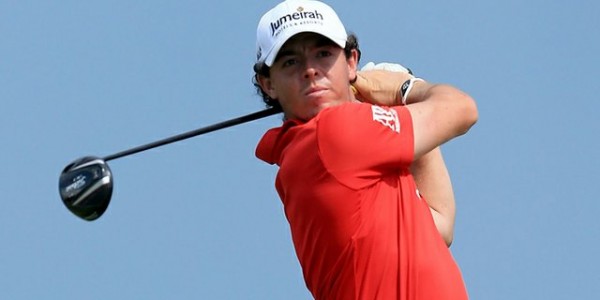
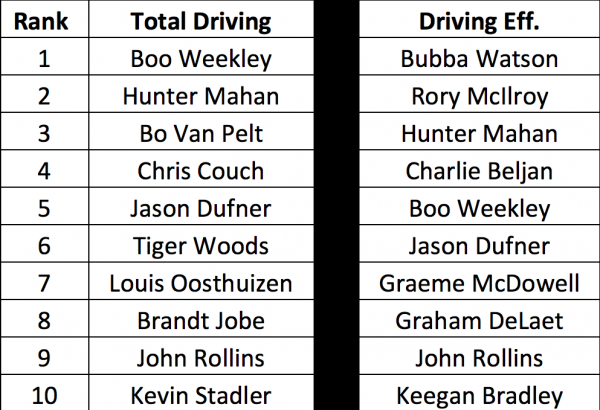
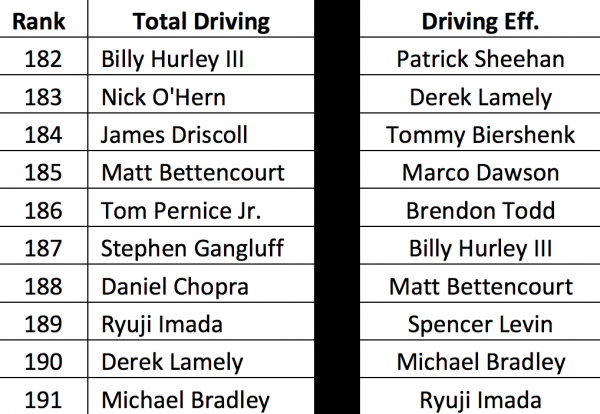
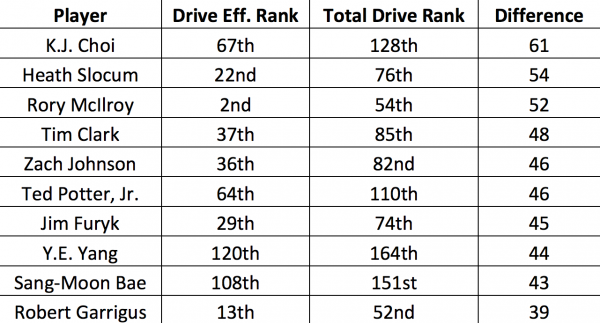
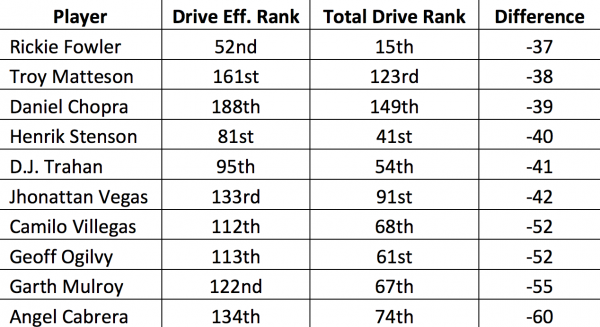














Philip
Feb 8, 2013 at 11:19 am
Great article. Recently, I’ve become intrigued by the statistics of the game of golf and other sports.
be_right
Jan 5, 2013 at 10:23 am
Great article….Do you publish your driving effectiveness stats anywhere? I’d love to follow along throughout the season.
stevielee
Nov 29, 2012 at 12:50 am
i disagree with The Pecker, this author somehow simply showed his approach and explained his findings without all the science behind it. now i can understand that even somedays that i couldnt hit single fairway and still had a decent day at the course. this is what you should get from an short online article.
Richie Hunt
Nov 15, 2012 at 5:00 pm
Hello,
I agree with many of your points, except for the last one stating that I am ‘fond of rendering the reader unable to form their own opinion.’
The difficult part for me is that I utilize a proprietary statistical model that took time, effort and mathematical knowledge to create. Thus, giving it away for free is not something I am willing to do.
This is not all that uncommon. I know the advanced metrics group for NFL research, Football Outsiders and Pro Football Focus, do not give away their models and algorithms either. But they present the information and their findings to their readers and then the readers decide how much sense it makes. This does typically lead to some debate as to how good certain players and teams are along with debating certain aspects and strategies of the game. But, they have obviously allowed their readers to render their own opinions because they have plenty of readers with plenty of opinions.
I think in this article, the reader can render some opinion on the importance of the Avg. Distance to the Edge of the Fairway metric along with the flawed nature of Total Driving from a basic mathematical standpoint and whether or not the metrics should be weighted evenly or disproportionally. The reader could also discern if a players I listed like KJ Choi, Rory McIlroy and Robert Garrigus are better or worse than their Total Driving metric indicates. If you have further questions, please let me know.
The Pecker
Nov 15, 2012 at 2:46 pm
While I think it is appropriate to incorporate more data into driving efficiency, I am unable to accept the author’s data for one simple reason. The author criticizes the PGA Tour for their “total driving” forumla, whereas, in the author’s analysis, they avoid mentioning any formula, rendering the reader unable to form their own opinion – something the author is clearly fond of doing.